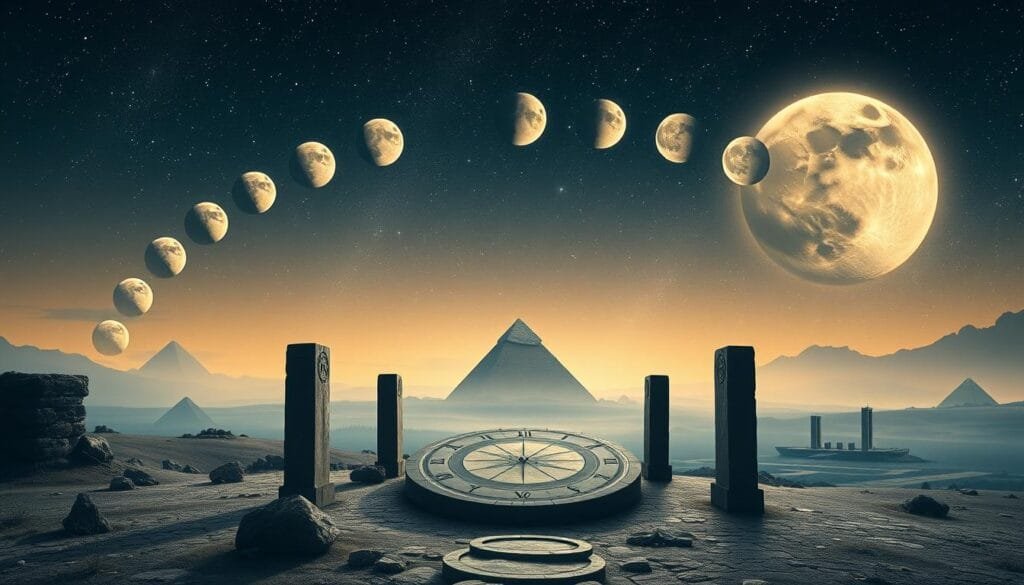Have you ever pondered how ancient people figured out time and space without today’s tech? Let’s explore the ancient lunar analemma. It’s an old astronomical tool that was key for stars’ navigation and keeping track of lunar time.
The lunar analemma, similar to the solar version, shows the moon’s journey across the sky from one spot on Earth over a year. Famous astronomers like Ptolemy spoke about it. It intrigued scientists and was vital for farming and navigating. The figure-eight pattern, captured by Jack Fishburn in New Jersey, shows its enduring importance.
Key Takeaways
- The ancient lunar analemma is important for olden timekeeping and calendars.
- Earth’s tilt of about 23.5 degrees affects the analemma’s shape.
- Before modern tech, this phenomenon was key for celestial navigation.
- Great Greek astronomers, such as Hipparchus and Ptolemy, added much to our understanding of the analemma.
- In ancient Egypt, analemma pictures on monuments showed its use in agriculture.
- The analemma’s figure-eight look changes depending on where you are on Earth.
- Studying the analemma visually, like Jack Fishburn’s work, helps us learn about lunar movements.
Introduction to the Lunar Analemma
The lunar analemma is important in history and today. It shows where the moon is in the sky at the same lunar time all year, from one spot on Earth. This pattern is key for science, farming, and finding our way.
Definition and Historical Context
Ancient people used the lunar analemma for navigating, tracking time, and planning farming. Greek scholars like Eratosthenes, who figured out the Earth is about 40,000 km around, helped understand the moon’s patterns. His work helped us know the Moon’s about 29.5-day cycle.
Claudius Ptolemy also added a lot by studying the Moon’s movements. His book, The Almagest, was a guide for 1,500 years. He also explored the precession of the equinoxes, a cycle taking about 25,771 years. This showed how complex celestial movements are.
How the Lunar Analemma Differs from the Solar Analemma
The lunar and solar analemmas both trace the paths of celestial bodies in the sky. But they are different. The solar analemma is about the sun’s path, taking 365 days because of Earth’s orbit around the Sun. The lunar analemma shows the Moon’s path, which is unique due to its own orbit around Earth.
This leads to different patterns. The Moon does not move in the same exact way as the Earth-Sun system. This gives the lunar analemma a special figure-eight pattern, different from the solar one.
The Role of the Lunar Analemma in Agriculture
Ancient civilizations used the lunar analemma for farming. They matched planting and harvesting times with the lunar cycles. This shows how closely ancient people linked astronomy with feeding their communities.
Studies of the Chankillo Archaeoastronomical Complex offer insight into ancient cultures’ grasp of seasons. Built over a thousand years before the Incas, this site highlights how celestial events guided farm planning.
Calendar Systems and Crop Cycles
Old farming calendars were key in setting the timing for growing crops. By tracking the moon’s position with the lunar analemma, farmers knew when to plant and. This knowledge allowed for high yields by planting at just the right times, thanks to lunar phase insights.
Use in Predicting Seasonal Changes
The lunar analemma was also used for predicting seasons. Ancient societies could predict weather and climate changes by observing the moon’s position. Predicting seasons helped them prepare for floods, droughts, and more.
The importance of the lunar analemma in ancient farming is clear. It was vital for survival and success. As we learn more about places like Chankillo, we gain a deeper understanding of how ancient people used astronomy in their daily lives. This highlights a complex knowledge base that has influenced modern agriculture.
Navigation Techniques Involving the Lunar Analemma
Lunar navigation techniques have been pivotal for ancient seafarers. Using the moon’s movements and the precise mapping of the lunar analemma, navigators could pinpoint their geographic location with a degree of accuracy unparalleled by other methods of the time.

Ancient Mariners and Lunar Positioning
Ancient mariners relied on the stars and moon for navigation. They noted the moon’s trajectory changes. These helped them build the lunar analemma.
This tool was crucial for navigating the open waters without modern instruments. Their observations under various weather conditions were highly effective.
“Navigators charted courses by observing the moon’s position against the backdrop of stars, enabling long voyages with remarkable precision,” – *Historical Maritime Society*.
Understanding the polarization degree and solar elevation angles helped them. It was especially useful under twilight conditions. Clear skies increased navigation efficiency, making star navigation easier even when the sun was low.
Analemma’s Impact on Timekeeping and Navigation
The lunar analemma’s integration into timekeeping revolutionized navigation. Sundials and Islamic water clocks showed this advanced understanding. Such tools marked the start of precise longitude determination at sea.
Recent advances combine traditional and new navigation methods. They use star sensors and advanced filters for accurate, GPS-independent navigation. These modern techniques build on ancient navigation wisdom.
How Did Ancient Cultures Utilize the Lunar Analemma?
The cultural impact of lunar analemma is seen in many ancient artifacts and records. These items show how deeply lunar analemmas were woven into the cultures and beliefs of early societies.
Significant Cultural Artifacts and Records
Ancient structures, like Newgrange in Ireland, built around 3200 BCE, aligned with solar and lunar events. This suggests a deep understanding of solstices and analemmas by those who built them. The winter solstice happens at 6:11 a.m. Eastern time in the Northern Hemisphere. It marks the shortest day, which was significant to ancient people.
Analemmatic sundials in ancient cultures show the use of the analemma in farming and spiritual practices. Ancient records of lunar analemma describe alignments with key lunar events. They show the figure-eight path of the analemma, affected by the earth’s tilt and orbit, and its variation with latitude.

Integration with Mythology and Rituals
The mythology connections of lunar analemmas played a big part in ancient ceremonies and stories. Mayan culture, for example, used shadow measurements to mark equinoxes and solstices. These weren’t just scientific practices but had deep mythological and spiritual significance.
In ancient Greek society, celestial body positions and their paths were part of myths. The analemma’s figure-eight represented life’s eternal cycle and renewal, important for societies dependent on agriculture. The winter and summer solstices, reflected in the analemma’s symmetry, were linked to festivals of death and rebirth.
| Solstice | Event | Significance |
|---|---|---|
| Winter Solstice | 6:11 a.m. Eastern time | Shortest day, marking death and renewal |
| Summer Solstice | ~12:00 p.m. Eastern time | Longest day, celebration of life |
The cultural impact of lunar analemma and details in ancient records of lunar analemma show the deep respect ancient societies had for these celestial events. They were integral to their daily life and mythical stories.
Lunar Analemma in Ancient Timekeeping
Long before clocks, ancient civilizations used the lunar analemma for timekeeping. They observed the moon’s rhythmic movements to track days and years. This was key for scheduling farming, social, and religious events.

They often based timekeeping on the moon’s phases. The lunar analemma helped synchronize community activities with lunar cycles. By tracking the moon’s position, societies could time crop planting, festivals, and rituals.
Ancient Egyptian and Babylonian societies excelled in using the lunar analemma. Their calendars included the moon’s movement. This allowed them to keep consistent time, despite Earth’s changes. For example, over 2,500 years, clocks would drift by four hours. Yet, these societies achieved remarkable time accuracy with their methods.
The lunar analemma played a big role in daily life and forecasting seasons. Early cultures displayed great skill and accuracy in time recording. Their understanding of lunar cycles helped predict seasonal shifts, vital for agriculture.
Astronomical Significance of the Lunar Analemma
The lunar analemma has greatly impacted astronomy, especially in shaping early theories and improving navigation among the stars. Ancient astronomers charted the moon’s patterns. These led to key insights into our solar system’s structure and how celestial bodies move.
Influence on Early Astronomical Models
Studying the lunar analemma changed early models of the cosmos. Hipparchus, for example, used it to calculate the year’s length almost perfectly. His findings of a 365.2467-day year are very close to today’s 365.2422 days. These calculations helped refine early astronomy and deepen our understanding of the universe.
The lunar phases’ cyclical nature, shown in lunar calendars, also highlighted the analemma’s importance. For instance, the Full Moon falls on the same dates yearly. This regularity proved celestial events’ predictability and their role in creating accurate astronomical models.
Connections to Celestial Navigation
The lunar analemma was crucial for celestial navigation. By plotting the moon’s location, early seafarers could pinpoint their position at sea. Sun positions on the equinoxes provided exact timing for navigational tools, improving sea travel accuracy.
Additionally, the analemma indicates the sun’s exact North-South alignment at noon on specific dates, like solstices and equinoxes. This was vital for ancient mariners, allowing them to sail great distances with high precision. A single arcsecond translates to about 30 meters on Earth, showcasing the lunar analemma’s role in enhancing navigation precise.
| Event | Time of Observation | Significance |
|---|---|---|
| Spring Equinox | 12:07 PM | Indicator of annual solar motion |
| Autumn Equinox | 11:50 AM | Shift in daily solar position |
| Winter Solstice | Varies by year | Sun aligns with North-South axis |
| Summer Solstice | Varies by year | Sun aligns with North-South axis |
The lunar analemma’s influence stretches from Hipparchus’ precise calculations to significant improvements in navigation. These developments not only improved understanding of the cosmos but also paved the way for future discoveries.
Educational Value of the Lunar Analemma
The lunar analemma’s teaching power grows as we discover more about it. Exploring its shape and movement helps us teach hard astronomy ideas in fun ways.
Modern Research and Applications
Recent studies of the analemma have deepened our celestial knowledge. The lunar analemma’s complex patterns are key in higher education. They help students understand how Earth’s movement connects to the stars. Using real-life examples makes hard ideas easier to get and mixes subjects like physics, math, and history.
About 10,000 Islamic astronomy texts still exist, including Almagest and Zij al-Sindhind translations. These texts link modern lessons to past astronomical leaps.
Teaching Tools and Visual Learning
The lunar analemma is a dynamic visual teaching method. It lets students see the analemma’s movements at different times and places. This reveals changes in shadows, temperatures, and Earth’s tilt. For instance, shadows grow longer in colder months and shorter when it’s warm.
These tools highlight how Earth’s tilt and spin work, using visuals. Activities like making analemma charts and reading ancient texts make learning active. They connect to scholars like Nasir al-Din al-Tusi and Ibn Yunus, enhancing the learning.
Conclusion
Our journey through the ancient uses of the lunar analemma shows it was more than just interesting. It was vital for timekeeping, navigation, and farming. This tool’s role in daily life and its cultural impact were significant. It played a part in everything from tracking crop cycles to guiding sailors.
Understanding the lunar analemma had a big effect. It made farming more productive and navigation more accurate. This wisdom was key to creating early models of the stars. It also keeps helping modern scientists, showing just how smart ancient people were.
Today, this ancient knowledge enriches education. It’s great for visual learning and brings different subjects together. Studying the analemma boosts students’ problem-solving skills and gets them excited about science and math. The lunar analemma reminds us of humanity’s endless desire to understand the universe.
FAQ
What is the lunar analemma?
The lunar analemma shows the moon’s position in the sky over a year. This is from one spot on Earth. It looks like a figure-eight pattern.
How was the lunar analemma used in ancient celestial navigation?
Ancient sailors used the lunar analemma to find their place and keep time at sea. It gave them key points for where the moon would be, which was vital before we had compasses or GPS.
What is the historical significance of the lunar analemma for agricultural practices?
Long ago, farmers used the lunar analemma to make their calendars. This helped them know the best times for planting and harvesting. It matched up with the lunar phases and seasons shown by the moon’s position.
How does the lunar analemma differ from the solar analemma?
The lunar analemma maps the moon’s unique journey, not the sun’s. It shows different declination patterns because of how the moon orbits Earth.
What role did the lunar analemma play in ancient timekeeping?
Before clocks, people used the lunar analemma to keep track of time. This was key for organizing farming, social, and religious activities.
How did the lunar analemma influence early astronomical models?
By studying the lunar analemma, ancient astronomers began to understand our solar system. They learned about how the heavens move.
What cultural artifacts illustrate the historical use of the lunar analemma?
Things like sundials and records in the church of Brou show how the lunar analemma was part of culture, myths, and rituals.
How is the lunar analemma used in modern education?
Now, the lunar analemma is a teaching tool in astronomy. It explains Earth’s motion and space patterns in a clear, visual way, making learning fun and connected.
